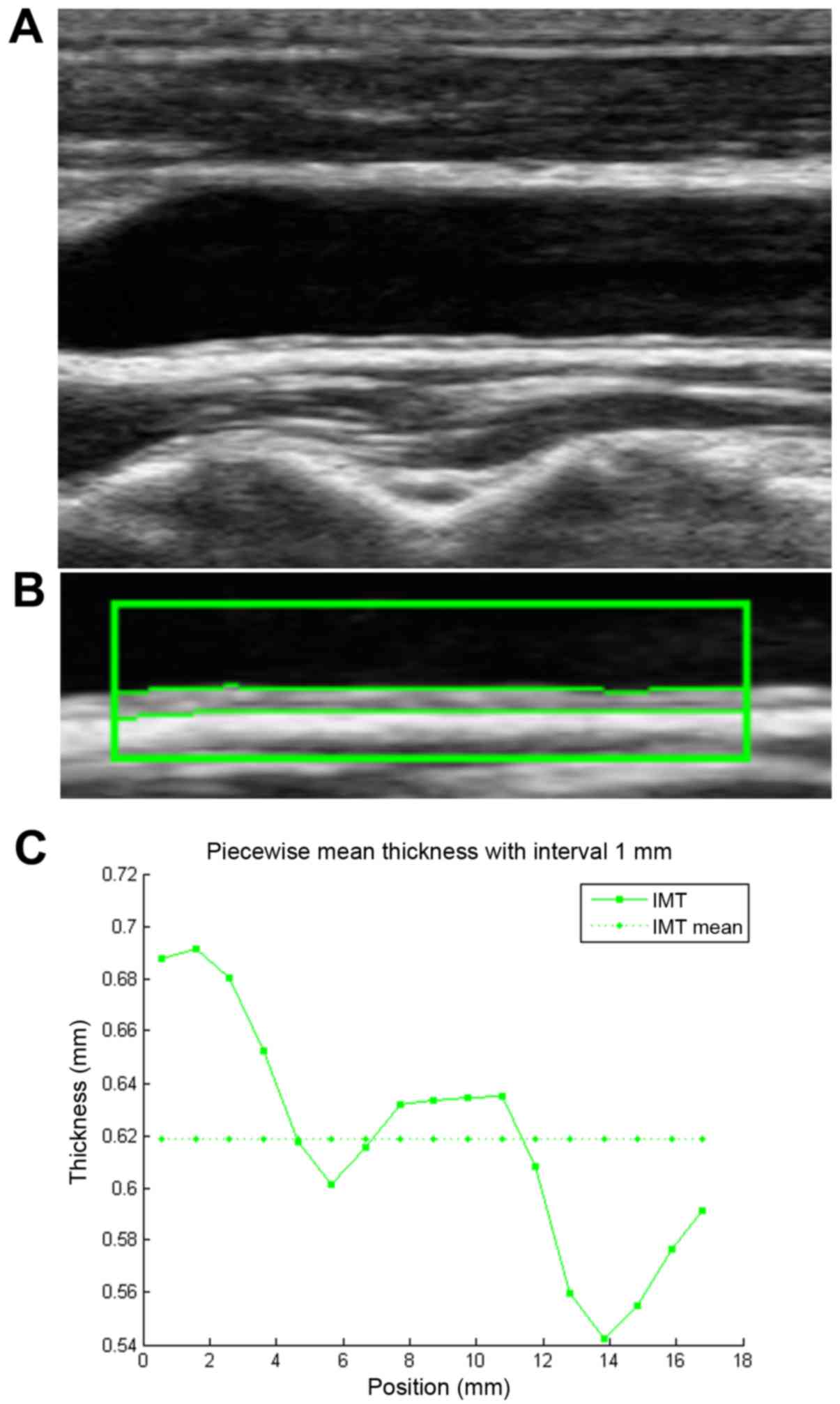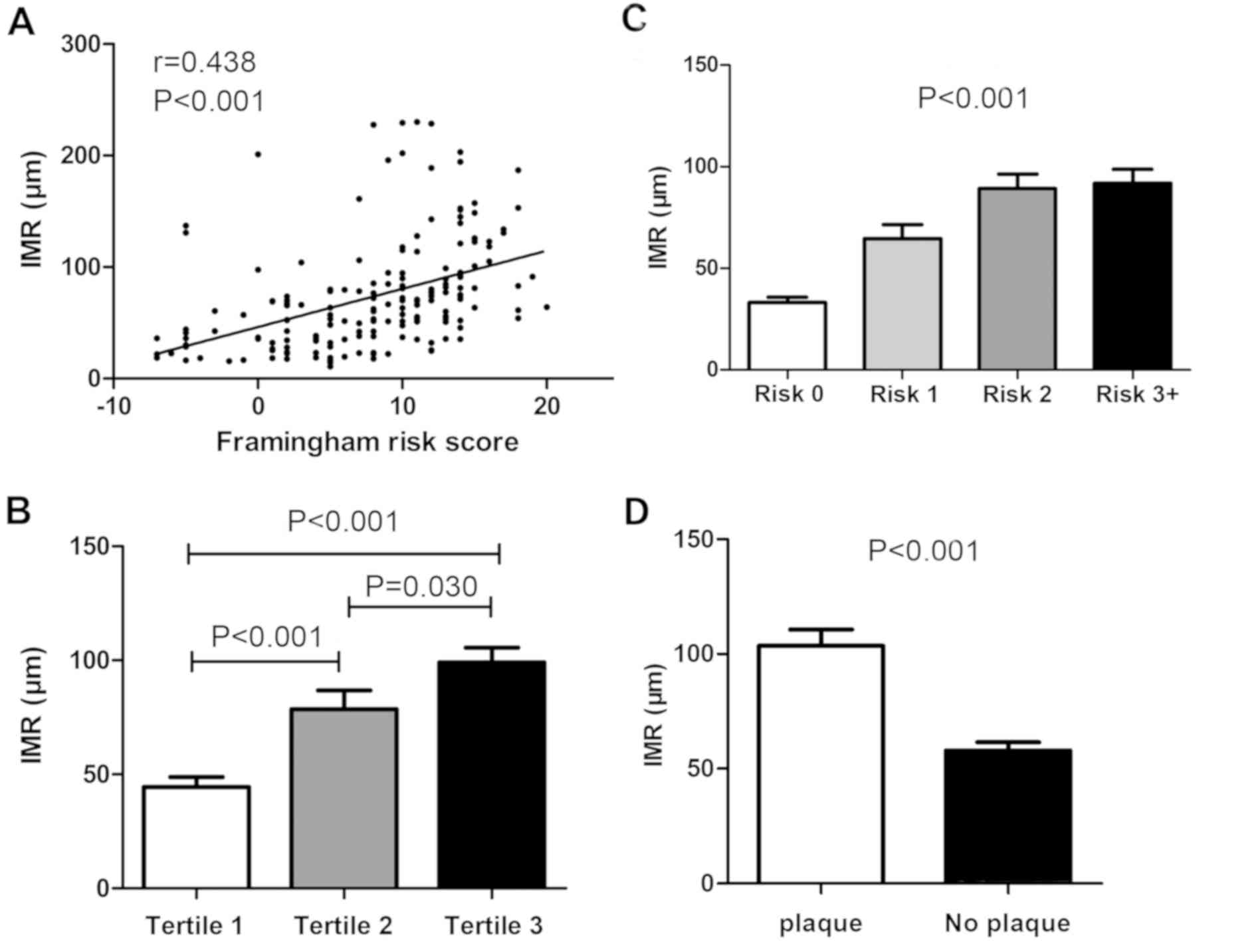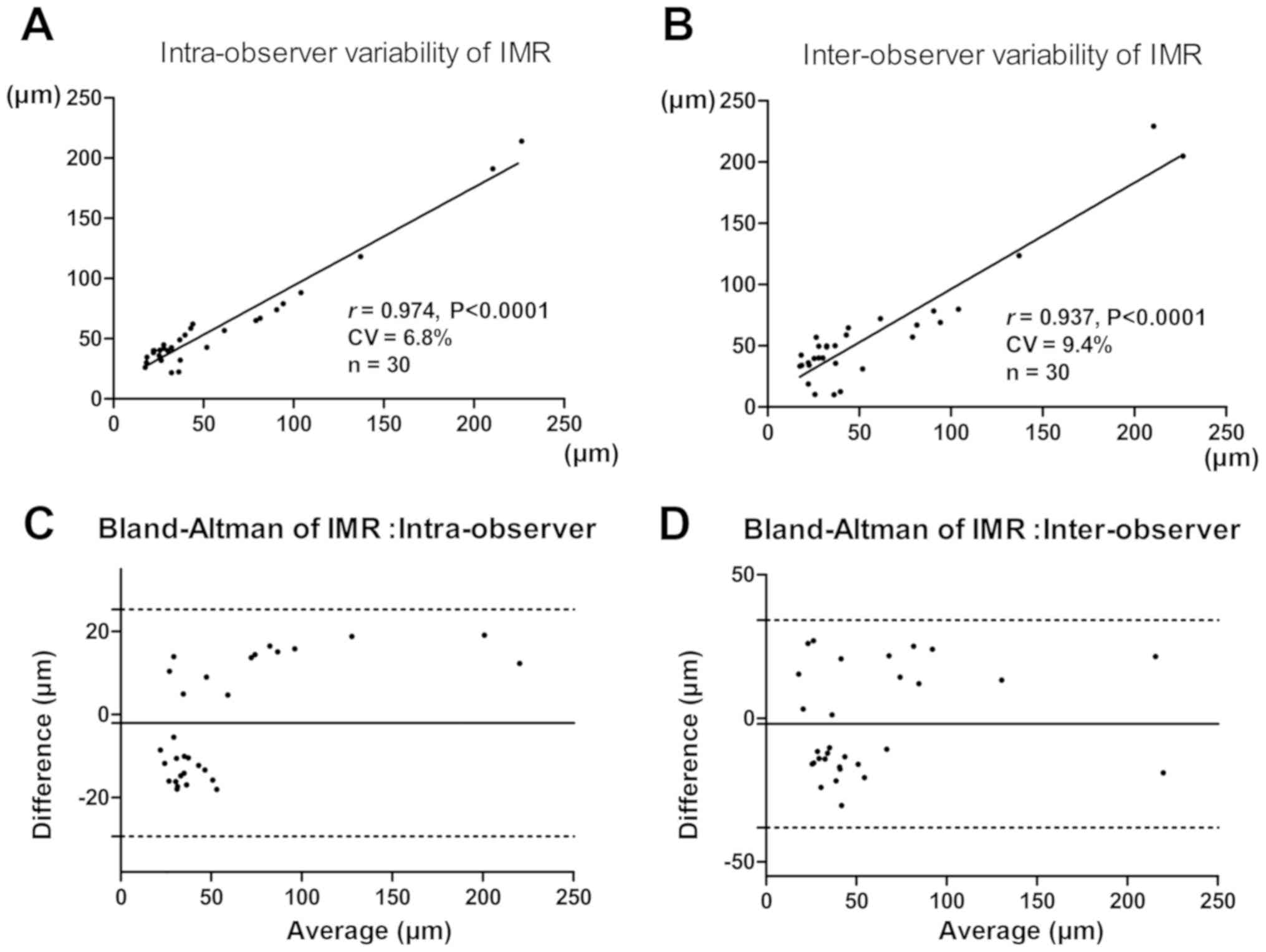|
1
|
He J, Gu D, Wu X, Reynolds K, Duan X, Yao
C, Wang J, Chen CS, Chen J, Wildman RP, et al: Major causes of
death among men and women in China. N Engl J Med. 353:1124–1134.
2005. View Article : Google Scholar : PubMed/NCBI
|
|
2
|
Touboul PJ, Labreuche J, Bruckert E,
Schargrodsky H, Prati P, Tosetto A, Hernandez-Hernandez R, Woo KS,
Silva H, Vicaut E and Amarenco P: Hdl-c, triglycerides and carotid
IMT: A meta-analysis of 21,000 patients with automated edge
detection IMT measurement. Atherosclerosis. 232:65–71. 2014.
View Article : Google Scholar : PubMed/NCBI
|
|
3
|
Lethen H, Tries HP, Kersting S, Bramlage P
and Lambertz H: Improvement of coronary microvascular function
after angiotensin receptor blocker treatment with irbesartan in
patients with systemic hypertension. J Clin Hypertens (Greenwich).
13:155–161. 2011. View Article : Google Scholar : PubMed/NCBI
|
|
4
|
Luijendijk P, Lu H, Heynneman FB, Huijgen
R, de Groot EE, Vriend JW, Vliegen HW, Groenink M, Bouma BJ and
Mulder BJ: Increased carotid intima-media thickness predicts
cardiovascular events in aortic coarctation. Int J Cardiol.
176:776–781. 2014. View Article : Google Scholar : PubMed/NCBI
|
|
5
|
Schmidt-Trucksass A, Sandrock M, Cheng DC,
Müller HM, Baumstark MW, Rauramaa R, Berg A and Huonker M:
Quantitative measurement of carotid intima-media roughness-effect
of age and manifest coronary artery disease. Atherosclerosis.
166:57–65. 2003. View Article : Google Scholar : PubMed/NCBI
|
|
6
|
Dalla Pozza R, Pirzer R, Beyerlein A,
Weberruß H, Oberhoffer R, Schmidt-Trucksäss A, Netz H and Haas N:
Beyond intima-media-thickness: Analysis of the carotid
intima-media-roughness in a paediatric population. Atherosclerosis.
251:164–169. 2016. View Article : Google Scholar : PubMed/NCBI
|
|
7
|
Homma S, Hirose N, Ishida H, Ishii T and
Araki G: Carotid plaque and intima-media thickness assessed by
b-mode ultrasonography in subjects ranging from young adults to
centenarians. Stroke. 32:830–835. 2001. View Article : Google Scholar : PubMed/NCBI
|
|
8
|
Lind L: Circulating markers of
inflammation and atherosclerosis. Atherosclerosis. 169:203–214.
2003. View Article : Google Scholar : PubMed/NCBI
|
|
9
|
Willerson JT: Systemic and local
inflammation in patients with unstable atherosclerotic plaques.
Prog Cardiovasc Dis. 44:469–478. 2002. View Article : Google Scholar : PubMed/NCBI
|
|
10
|
Toutouzas K, Grassos H, Synetos A,
Drakopoulou M, Tsiamis E, Moldovan C, Agrogiannis G, Patsouris E,
Siores E and Stefanadis C: A new non-invasive method for detection
of local inflammation in atherosclerotic plaques: Experimental
application of microwave radiometry. Atherosclerosis. 215:82–89.
2011. View Article : Google Scholar : PubMed/NCBI
|
|
11
|
Belcaro G, Nicolaides AN, Laurora G,
Cesarone MR, De Sanctis M, Incandela L and Barsotti A: Ultrasound
morphology classification of the arterial wall and cardiovascular
events in a 6-year follow-up study. Arterioscler Thromb Vasc Biol.
16:851–856. 1996. View Article : Google Scholar : PubMed/NCBI
|
|
12
|
Mancia G, Fagard R, Narkiewicz K, Redón J,
Zanchetti A, Böhm M, Christiaens T, Cifkova R, De Backer G,
Dominiczak A, et al: 2013 ESH/ESC guidelines for the management of
arterial hypertension: The task force for the management of
arterial hypertension of the european society of hypertension (ESH)
and of the european society of cardiology (ESC). J Hypertens.
31:1281–1357. 2013. View Article : Google Scholar : PubMed/NCBI
|
|
13
|
Gnasso A, Irace C, Mattioli PL and Pujia
A: Carotid intima-media thickness and coronary heart disease risk
factors. Atherosclerosis. 119:7–15. 1996. View Article : Google Scholar : PubMed/NCBI
|
|
14
|
American Diabetes Association: Standards
of medical care in diabetes-2011. Diabetes Care. 1 (Suppl
34):S11–S61. 2011. View Article : Google Scholar
|
|
15
|
Zhou B; Coorperative Meta-Analysis Group
Of China Obesity Task Force, : Predictive values of body mass index
and waist circumference to risk factors of related diseases in
Chinese adult population. Zhonghua Liu Xing Bing Xue Za Zhi.
23:5–10. 2002.(In Chinese). PubMed/NCBI
|
|
16
|
Expert Panel on Detection and Evaluation
and Treatment of High Blood Cholesterol in Adults, . Executive
summary of the third report of the national cholesterol education
program (NCEP) expert panel on detection, evaluation, and treatment
of high blood cholesterol in adults (Adult Treatment Panel III).
JAMA. 285:2486–2497. 2001. View Article : Google Scholar : PubMed/NCBI
|
|
17
|
Touboul PJ, Hennerici M, Meairs S, Adams
H, Amarenco P, Bornstein N, Csiba L, Desvarieux M, Ebrahim S,
Hernandez Hernandez R, et al: Mannheim carotid intima-media
thickness and plaque consensus (2004-2006-2011). An update on
behalf of the advisory board of the 3rd, 4th and 5th watching the
risk symposia, at the 13th, 15th and 20th European stroke
conferences, mannheim, Germany, 2004, Brussels, Belgium, 2006, and
hamburg, Germany, 2011. Cerebrovasc Dis. 34:290–296. 2012.
View Article : Google Scholar : PubMed/NCBI
|
|
18
|
Xu X, Zhou Y, Cheng X, Song E and Li G:
Ultrasound intima-media segmentation using hough transform and dual
snake model. Comput Med Imaging Graph. 36:248–258. 2012. View Article : Google Scholar : PubMed/NCBI
|
|
19
|
Wendelhag I, Gustavsson T, Suurküla M,
Berglund G and Wikstrand J: Ultrasound measurement of wall
thickness in the carotid artery: Fundamental principles and
description of a computerized analysing system. Clin Physiol.
11:565–577. 1991. View Article : Google Scholar : PubMed/NCBI
|
|
20
|
Oh J, Wunsch R, Turzer M, Bahner M, Raggi
P, Querfeld U, Mehls O and Schaefer F: Advanced coronary and
carotid arteriopathy in young adults with childhood-onset chronic
renal failure. Circulation. 106:100–105. 2002. View Article : Google Scholar : PubMed/NCBI
|
|
21
|
Polak JF, Pencina MJ, Pencina KM,
O'Donnell CJ, Wolf PA and D'Agostino RB Sr: Carotid-wall
intima-media thickness and cardiovascular events. N Engl J Med.
365:213–221. 2011. View Article : Google Scholar : PubMed/NCBI
|
|
22
|
Gardin JM, Bartz TM, Polak JF, O'Leary DH
and Wong ND: What do carotid intima-media thickness and plaque add
to the prediction of stroke and cardiovascular disease risk in
older adults? The cardiovascular health study. J Am Soc
Echocardiogr. 27:998–1005. 2014. View Article : Google Scholar : PubMed/NCBI
|
|
23
|
Polak JF, Szklo M and O'Leary DH:
Associations of coronary heart disease with common carotid artery
near and far wall intima-media thickness: The Multi-Ethnic Study of
Atherosclerosis. J Am Soc Echocardiogr. 28:1114–1121. 2015.
View Article : Google Scholar : PubMed/NCBI
|
|
24
|
Gigante B, Leander K, Vikström M,
Baldassarre D, Veglia F, Strawbridge RJ, McLeod O, Gertow K,
Sennblad B, Shah S, et al: Low levels of IgM antibodies against
phosphorylcholine are associated with fast carotid intima media
thickness progression and cardiovascular risk in men.
Atherosclerosis. 236:394–399. 2014. View Article : Google Scholar : PubMed/NCBI
|
|
25
|
Wu Y, Xie M, Zhang L, Lu X, Cheng X and Lv
Q: Carotid intima-media roughness and elasticity in hypertensive
patients with normal carotid intima-media thickness. J Ultrasound
Med. 2018:(Epub ahead of print).
|
|
26
|
Raitakari OT, Juonala M, Kähönen M,
Taittonen L, Laitinen T, Mäki-Torkko N, Järvisalo MJ, Uhari M,
Jokinen E, Rönnemaa T, et al: Cardiovascular risk factors in
childhood and carotid artery intima-media thickness in adulthood:
The Cardiovascular Risk in Young Finns Study. JAMA. 290:2277–2283.
2003. View Article : Google Scholar : PubMed/NCBI
|
|
27
|
Cheng X, Zhou Y, Jin Y, Li G, Wang H and
Song E: Intima-medial thickness homogeneity in the common carotid
artery: Measurement method and preliminary clinical study. J Clin
Ultrasound. 40:559–565. 2012. View Article : Google Scholar : PubMed/NCBI
|
|
28
|
Otsuka F, Kramer MC, Woudstra P, Yahagi K,
Ladich E, Finn AV, de Winter RJ, Kolodgie FD, Wight TN, Davis HR,
et al: Natural progression of atherosclerosis from pathologic
intimal thickening to late fibroatheroma in human coronary
arteries: A pathology study. Atherosclerosis. 241:772–782. 2015.
View Article : Google Scholar : PubMed/NCBI
|
|
29
|
Bentzon JF, Otsuka F, Virmani R and Falk
E: Mechanisms of plaque formation and rupture. Circ Res.
114:1852–1866. 2014. View Article : Google Scholar : PubMed/NCBI
|
|
30
|
Graf IM, Schreuder FH, Hameleers JM, Mess
WH, Reneman RS and Hoeks AP: Wall irregularity rather than
intima-media thickness is associated with nearby atherosclerosis.
Ultrasound Med Biol. 35:955–961. 2009. View Article : Google Scholar : PubMed/NCBI
|
|
31
|
Ishizu T, Ishimitsu T, Kamiya H, Seo Y,
Moriyama N, Obara K, Watanabe S and Yamaguchi I: The correlation of
irregularities in carotid arterial intima-media thickness with
coronary artery disease. Heart Vessels. 17:1–6. 2002. View Article : Google Scholar : PubMed/NCBI
|

















